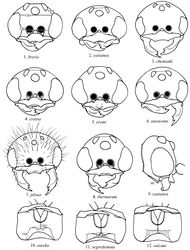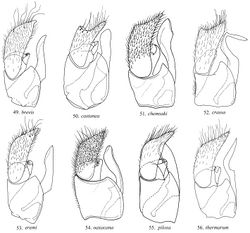Colocistis eremi
| Notice: | This page is derived from the original publication listed below, whose author(s) should always be credited. Further contributors may edit and improve the content of this page and, consequently, need to be credited as well (see page history). Any assessment of factual correctness requires a careful review of the original article as well as of subsequent contributions.
If you are uncertain whether your planned contribution is correct or not, we suggest that you use the associated discussion page instead of editing the page directly. This page should be cited as follows (rationale):
Citation formats to copy and paste
BibTeX: @article{Kimsey2013JournalofHymenopteraResearch33, RIS/ Endnote: TY - JOUR Wikipedia/ Citizendium: <ref name="Kimsey2013Journal of Hymenoptera Research33">{{Citation See also the citation download page at the journal. |
Ordo: Hymenoptera
Familia: Tiphiidae
Genus: Colocistis
Name
Colocistis eremi (Bradley) – Wikispecies link – Pensoft Profile
- Brachycistis eremi Bradley, 1917:279. Holotype male; USA: California, Imperial County, Calexico (CUIC).
Diagnosis
Only Colocistis brevis and Colocistis eremi have two submarginal cells and the costal vein not extending beyond the stigma. Colocistis eremi can be distinguished from Colocistis brevis by the strongly elevated hypostomal carina and the aedeagus straight in lateral view as discussed under Colocistis brevis.
Description
Male.
Body length. 5–12 mm.
Head (Fig. 5). Compound eyes enlarged, extending laterally far beyond temples; ocelli enlarged, diameter of lateral ocellus at least 0.7× OOL; lateral ocellus removed from vertex by 0.5 or less one ocellar diameter; impressed line between lateral ocelli absent or reduced to row of punctures; clypeus raised medially and visible above mandibles in lateral view, apex not bounded laterally by strong teeth; gular carina raised anteriorly; LID 0.6× UID; flagellomere I length 2.7–2.8× breadth; flagellomere II length 3× breadth; flagellomere IX length 3.6–3.7× breadth; occipital carina strong, complete ventrally; mandible narrowest submedially, tapering apically toward ventroapical tooth.
Mesosoma. Pronotal punctures shallow, 0.5–1.0 puncture diameters apart, shoulders well-developed, not produced laterally; forefemur without stout spines; foretibia without spines except apically; basitarsus with two spines on outer surface; tibial spur subequal to length of basitarsus; hindcoxa with longitudinal dorsal carina basally tooth-like; scutal punctures 1–2 puncture diameters apart; mesopleural punctures nearly contiguous; scutellum slightly elevated above level of propodeum, punctures 1–3 puncture diameters apart; postscutellum impunctate medially, densely punctate laterally; propodeum dorsal surface with longitudinal sublateral carinae, shallowly rugose, without transverse carina separating dorsal from posterior surface, posterior surface punctures deep, 1–3 puncture diameters apart, lateral surface punctures 0.5–1.0 puncture diameters apart dorsally, impunctate ventrally; forewing with two submarginal cells, costa not extending along wing margin beyond stigma.
Metasoma. Tergum I without transverse carina; sternum II without raised area anteriorly.
Genitalia (Figs 45, 53) in lateral view with gonostylus broadly curved to nearly straight at tip, aedeagus not decurved.
Color: Head and body unicolorous castaneous; vestiture pale brown.
Female unknown.
Distribution
(Fig. 36): USA: Arizona: Coconino, Maricopa, Pima, Pinal, Yuma counties; California: Imperial, Inyo,Riverside, San Bernardino, San Diego Counties; Nevada: Lincoln, Nye counties; Mexico: Baja California, Baja California Sur, Sonora; 518 males were examined (BME, EMEC, KSBS, LACM).
Taxon Treatment
- Kimsey, L; Wasbauer, M; 2013: Revision of the brachycistidine genus Colocistis Krombein, 1942 (Hymenoptera, Tiphiidae) Journal of Hymenoptera Research, 33: 1-24. doi
Images
|



